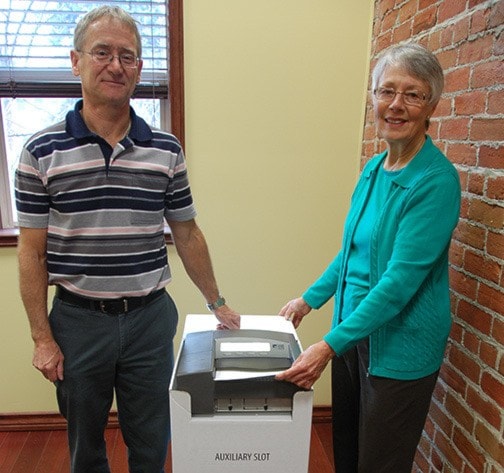Everybody relax; the machines are not taking over.
However, for the first time in Cranbrook's history of municipal voting, a computer will be used to tabulate all the results.
It's a change from tradition, as there used to be four separate ballots for mayor, council, school district trustee and referendums, as in the 2011 electoral cycle. Once ballots were marked, they were deposited into separate boxes and hand-counted.
The new system will still involve paper ballots, but a machine will take the ballots and deposit them into a sealed box, tracking all the results in a memory card.
Results should be available within an hour or two of polls closing.
These are the same machines that were recently used in the Toronto municipal election, according to Chief Electoral Officer Brian Wooff. The same machines will be used in Kimberley's election and in roughly 45 other municipalities across B.C.
"The actual vote, I think they're going to find is easier, because there's one piece of paper instead of four," said Wooff.
For the advance polling, the memory cards will track the results and be kept under strict lock and key by Wooff. Fears of tampering are overblown, according to Wooff, considering any meddler would have to have access to the machine, to the memory cards and to the ballots themselves.
So here's what the voting process will look like at the general election on Saturday, Nov. 15 at Laurie Middle School.
To be clear—voters will be given a paper ballot to fill out.
After marking their preferred candidates for mayor, council, school district trustee and the assent question on fluoridation, the ballot is then fed into the machine, which will store the results on the internal memory card.
On the ballot, each candidate will have a blank oval next to their name, which must be coloured in by pen to make the selection.
Once the ballot is filled out, voters can turn it upside down to preserve the secrecy of their selections, and feed it directly into the machine. The machine will catch the ballot and draw it into the ballot box, which will, of course, be sealed.
As the machine draws in the ballot, it will acknowledge on a screen that it is accepting one, and will keep a running tally of the number of ballots received.
The ballot will have all the aforementioned categories of mayor, council, school district trustee and the assent question.
So what happens if people over-vote and select two mayors? Or vote for nine council candidates?
The machine will reject the ballot on the spot after being fed into the tray.
The voter can go back, get another ballot and redo their selections and resubmit their new ballot into the machine. If a voter does not wish to redo another ballot the machine will be required to take the ballot and count the races that are not over-voted.
Now, here's where it gets a little tricky.
If a voter makes one selection for mayor, but over-votes for the council selection and, for example, marks 10 choices, the mayoral selection will still count.
Again, the machine will note the over-voting council selections, and give the option of spitting the ballot back to correct the over-voting from the council column.
Or, if the voter so chooses, they can force the machine to accept their ballot, as the mayoral selection will count, but their council choices will be considered spoiled.
The machine itself will be watched by electoral volunteers sworn to secrecy, so if anyone needs any help with the process, or has any questions about the machine accepting or rejecting their ballot, it will be available.
Advance polls open at the senior centre off the corner of the Mount Baker RV Park on 2nd street on Nov. 5-6 and Nov. 12 from 8 a.m. - 8 p.m.
For Area C residents voting for school district trustees, advance polls are on Nov. 5 and Nov. 13 at the RDEK boardroom.
Mail-in ballots can also be requested by contacting city hall or the RDEK office. Mail-in ballots will be fed into the machine for tabulation after polls close for the general election.
The advance poll memory card will be kept with no results tabulated under secret lock and key until the general election day when voting is over at 8 pm. After 8 pm the results from the Advance vote will be determined.
The vote tabulating machine will be on display at the JCI All Candidates Forum at the Key City Theatre on Wednesday evening. Wooff will be on hand to answer any questions from the public.
